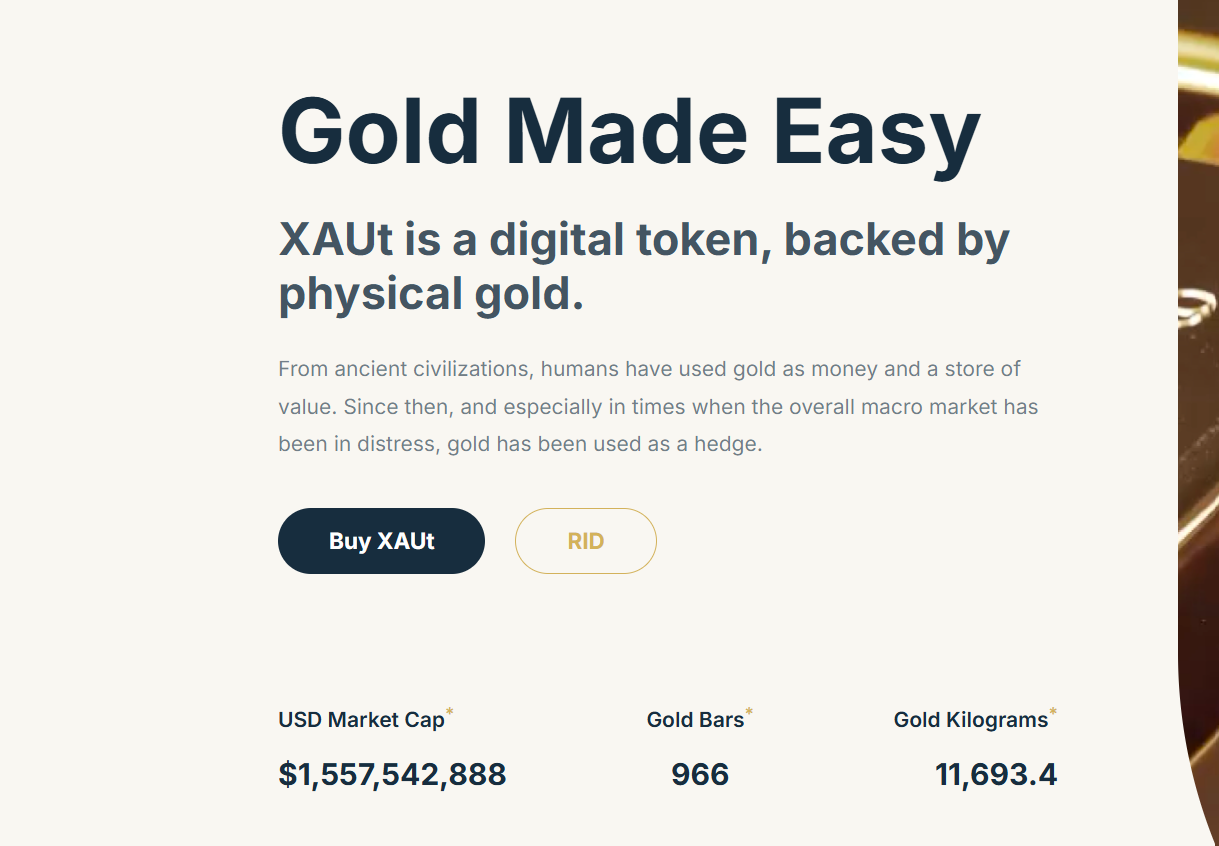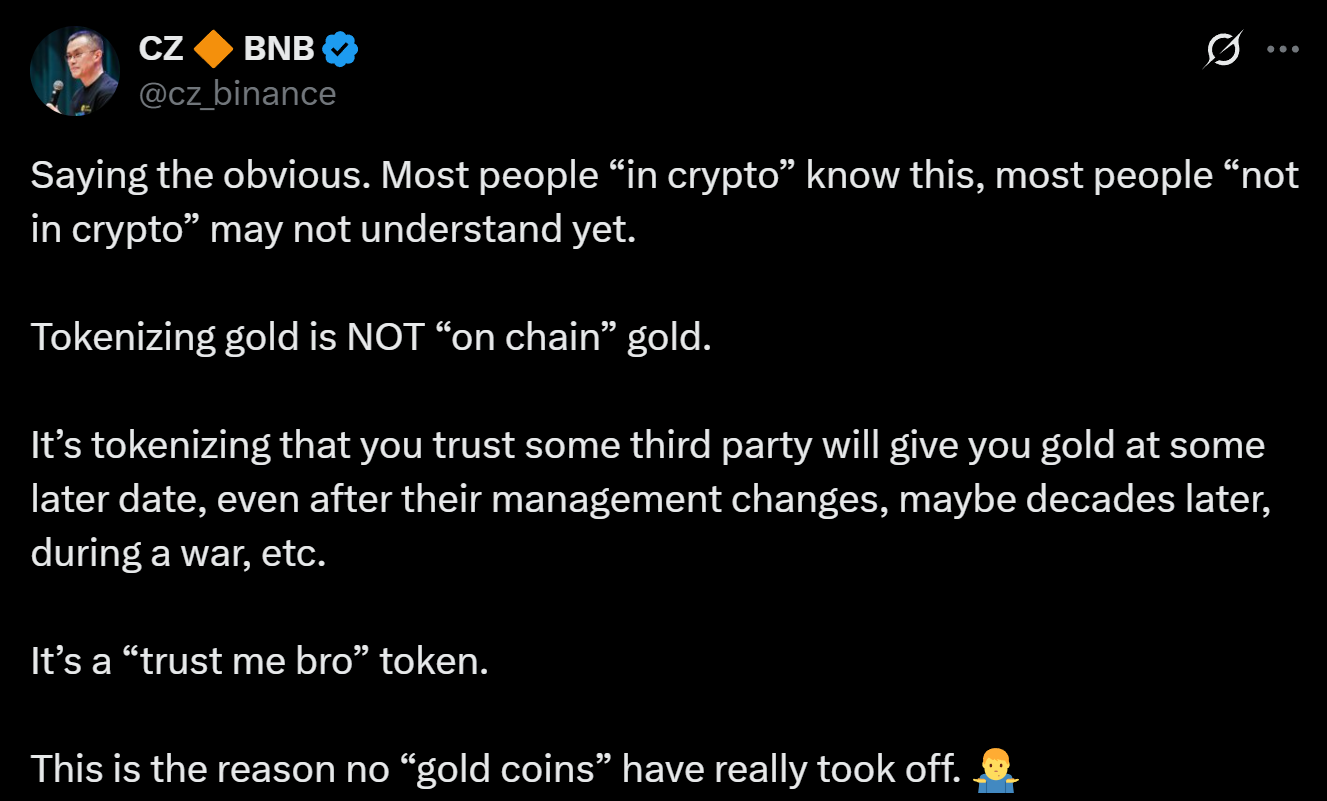From trustless BTC to tokenized gold, which one is the real “digital gold”?
Yes, I’m talking about gold in the physical sense. With increasing geopolitical risks and global macroeconomic uncertainty, the total market value of gold (at one point) reached $30 trillion, firmly holding the top spot among global assets.
Meanwhile, something quite interesting is happening in the Crypto world: in addition to Bitcoin, which is widely regarded as “digital gold,” physical gold is being rapidly on-chained: tokenized gold, represented by Tether Gold (XAUT), has gained new capabilities such as divisibility, programmability, and even interest generation through the RWA wave.
It is challenging a narrative that has long been almost entirely dominated by Bitcoin: “Who is the real digital gold?”
BTC: A Decade of Narrative Evolution
Is Bitcoin (BTC) a currency or an asset? Is its core function payment or a store of value? Or is it a risky asset similar to tech stocks?
This question has been present throughout almost the entire history of Bitcoin since its inception in 2009.
Although Satoshi Nakamoto clearly stated BTC’s “Electronic Cash” attribute in the white paper, with the evolution of its size, this has been a topic of constant reversal and community debate over the past 10 years—from an early means of payment to a “store of value” and an “alternative asset.”
The formal approval of spot ETFs in 2024, in particular, marked a turning point in the narrative. More people stopped being optimistic about Bitcoin becoming a “global currency” for transactions and payments. Instead, more and more people began to see Bitcoin as a store of value with a consensus basis, that is, “digital gold.”
Like gold, it is scarce in total quantity and its production is predictable and stable, but it also has advantages that gold cannot match: better divisibility (1 satoshi = 0.00000001 BTC), portability (cross-border transfer in seconds) and liquidity (7×24-hour market).
For this reason, Bitcoin has gradually become the third global store of value after the US dollar and gold in the macro monetary system.

Source: companiesmarketcap.com
According to companiesmarketcap, gold currently holds an absolute leading position among the world’s top 10 assets, with its total market value (28.4 trillion) far exceeding the sum of the next 9 (26 trillion).
It’s important to understand that even now, with BTC surpassing $100,000, its total market capitalization is only $2 trillion, roughly equivalent to 1/15th of the total market capitalization of gold. This is precisely the underlying motivation for the BTC community to continuously emphasize the “digital gold” narrative, which aims at the largest and oldest store of value in the traditional financial world.
Interestingly, while BTC is striving to align itself with the narrative of “digital gold,” gold itself is also being “digitized.”
The most direct incentive is the rapid rise of tokenized gold, represented by Tether Gold (XAUT) and PAX Gold (PAXG), along with the record highs of real-world gold and the RWA wave this year.
Since they are pegged to physical gold, each token issued is backed by an equal amount of physical gold reserves. Therefore, these “digital gold” products are undoubtedly a new financial species in the Crypto and TradeFi fields.
The “sudden rise” of the golden RWA wave
In fact, using the term “emerging as a dark horse” may not be entirely accurate for tokenized gold.
Strictly speaking, neither XAUT, currently the largest product, nor PAXG, which follows closely behind, are newly launched trending products. On the contrary, the current RWA wave and macro market conditions have helped them gain new strategic significance and market attention.
Taking XAUT as an example, its early development can be traced back to the end of 2019. At that time, Paolo Ardoino, the chief technology officer of Bitfinex and Tether, revealed that Tether was planning to launch a gold-backed stablecoin, Tether Gold, and the XAUT white paper was released to the public on January 28, 2022.
The white paper explicitly states that each XAUT token represents ownership of one ounce of physical gold, and Tether guarantees that it has prepared physical reserves of gold corresponding to the issuance quantity, all of which are stored in “Swiss vaults with first-class security”.
As of the time of writing, XAUT’s total issuance has exceeded US$1.55 billion, representing a physical reserve of approximately 966 gold bars (totaling 11,693.4 kilograms).

Source: Tether
In fact, Tether Gold’s white paper clearly 디파이nes its own advantages:
- Compared to physical gold, “gold stablecoins” can divide the indivisible precious metal into smaller denominations, making them easier to carry and transport, and greatly reducing the threshold for personal investment.
- Compared to gold ETFs, it enables 24/7 trading of assets, has no custody fees, and can significantly improve the speed and efficiency of asset transfer.
In other words, Tether Gold believes it can help users obtain high liquidity and divisibility while owning the gold it backs on.
In other words, tokenization gives real gold the unique “digital attributes” of BTC, allowing it to be fully absorbed by the digital world for the first time, becoming an asset unit that can be freely circulated, combined, and calculated. It is this step that makes tokenized gold products like XAUT no longer just “on-chain gold certificates,” but opens up a vast space on the blockchain.
Of course, this trend has also made the market rethink: when gold and BTC become on-chain assets, is their relationship one of competition or symbiosis?
A Discussion on 토큰ized Gold and Digital Gold
Overall, if the core narrative of BTC is “scarcity consensus in the digital world”, then the biggest difference of tokenized gold (XAUT/PAXG) lies in “introducing scarcity consensus into the digital world”.
This is a subtle yet fundamental difference: BTC creates trust entirely from scratch, while tokenized gold digitizes the traditional trust structure, as CZ recently stated in a tweet:
“Tokenized gold is not true on-chain gold, but rather based on trust in the issuer’s ability to fulfill its obligations. Even in extreme circumstances, such as management changes or war, users still need to rely on the continuation of this trust system.”

This statement highlights the fundamental difference between tokenized gold and Bitcoin: Bitcoin’s trust is based on algorithmic consensus, without any issuer or custodian, while tokenized gold’s trust is based on institutional credit—requiring the belief that Tether or Paxos will strictly adhere to their reserve commitments.
This also means that Bitcoin is a product of “trustlessness,” while tokenized gold is an extension of “trust re-establishment.”
Of course, if we only consider the added value from the perspective of asset value, in the traditional financial system, the core value of gold lies in its role as a safe haven and store of value. However, in the context of blockchain, tokenized gold has, for the first time, gained programmability:
- It can be used as collateral for DeFi protocols to lend stablecoins on platforms such as Aave and Compound for leverage or yield management;
- It can be integrated into smart contract logic to become yield-bearing gold, potentially enabling gold to generate interest.
- It can also circulate freely between different networks through cross-chain bridges, becoming a stable liquid asset in a multi-chain ecosystem;
The essence of this change is that gold has transformed from a static store of value into a dynamic financial unit. Through tokenization technology, gold has been given digital attributes similar to Bitcoin—verifiable, liquid, combinable, and computable. This means that gold is no longer just a symbol of value lying in a vault, but has become a “living asset” in the blockchain world that can participate in generating returns and credit.
Objectively speaking, with tightening liquidity and weak alt assets, the rise of RWA has brought traditional assets such as gold, bonds, and stocks back into the 암호화폐 spotlight. The popularity of tokenized gold precisely illustrates that the market is seeking a more stable and certain on-chain value anchor.
From this perspective, tokenized gold, which is accelerating its development under the RWA wave, is not intended (and cannot) to replace BTC, but rather serves as a perfect complement to the BTC “digital gold” narrative, becoming a new financial species that combines the efficient liquidity of digital assets with the safe-haven certainty of traditional gold.
이 글은 인터넷에서 퍼왔습니다: From trustless BTC to tokenized gold, which one is the real “digital gold”?Recommended Articles
Related: 78 million repurchase + CCMs: How deep is Pump.fun’s Meme hegemony moat?
Original translation: Saoirse, Foresight News You’ve probably all noticed that Pump.fun has recently regained its market dominance. In my previous article, I focused on analyzing competitors and the current state of trading terminals. In this article, I’ll focus on the bullish logic behind Pump.fun and the vast market opportunities emerging in CCMs (Creator Capital 시장s) through native Launchpad live streaming. Today, the PUMP token price is comfortably above its ICO fundraising price, and the platform has rolled out numerous updates, indicating a positive outlook. Let’s delve deeper into the details. PUMP’s revenue flywheel Since the ICO, more than half of the participants have sold their tokens, and a large number of tokens have been transferred to other wallets – this is most likely to be sold in batches to different…







